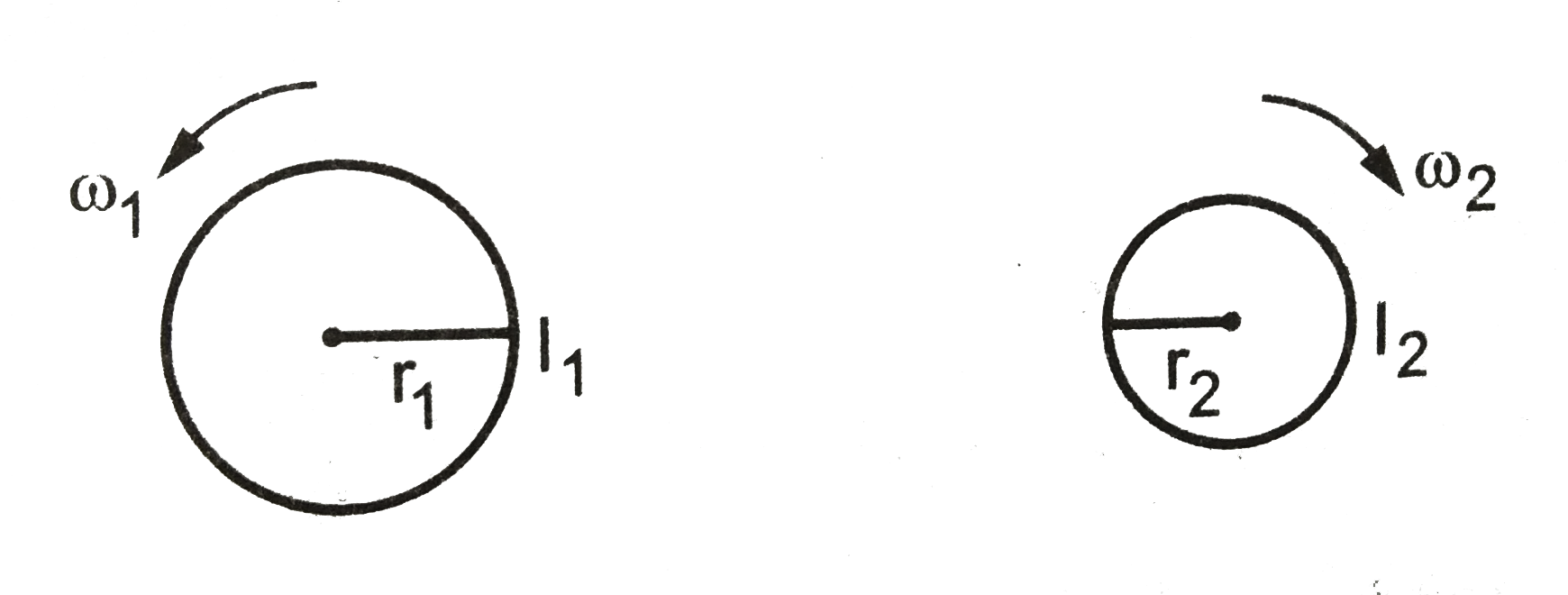Two discs of moments of inertia I1 and I2 about their respective axes (normal to the disc and passing through the centre), and rotating with angular speed ω1 and ω2 are brought into contact face to face with their axes of rotation coincident. What is the loss in kinetic energy of the system in the process?
I1I2(ω1−ω2)22(I1+I2)
I1I2(ω1−ω2)22(I1+I2)
I1I2(ω1+ω2)2I1−I2
I1I2(ω1+ω2)22(I1−I2)
The correct Answer is:a
To find the loss in kinetic energy when two discs are brought into contact, we can follow these steps:
Step 1: Calculate Initial Kinetic Energy
The initial kinetic energy of the system is the sum of the kinetic energies of both discs. The formula for rotational kinetic energy is given by:
KE=12Iω2
Thus, the initial kinetic energy KEinitial can be expressed as:
KEinitial=12I1ω21+12I2ω22
Step 2: Determine Final Angular Velocity
When the discs are brought into contact, they will rotate together with a common angular velocity ω. To find this angular velocity, we use the conservation of angular momentum:
Linitial=Lfinal
The initial angular momentum is:
Linitial=I1ω1+I2ω2
The final angular momentum when both discs are rotating together is:
Lfinal=(I1+I2)ω
Setting these equal gives:
I1ω1+I2ω2=(I1+I2)ω
From this, we can solve for ω:
ω=I1ω1+I2ω2I1+I2
Step 3: Calculate Final Kinetic Energy
The final kinetic energy KEfinal of the system when both discs are rotating together is:
KEfinal=12(I1+I2)ω2
Substituting the expression for ω:
KEfinal=12(I1+I2)(I1ω1+I2ω2I1+I2)2
This simplifies to:
KEfinal=12(I1ω1+I2ω2)2I1+I2
Step 4: Calculate Loss in Kinetic Energy
The loss in kinetic energy ΔKE is given by:
ΔKE=KEinitial−KEfinal
Substituting the expressions we derived:
ΔKE=(12I1ω21+12I2ω22)−12(I1ω1+I2ω2)2I1+I2
Step 5: Simplify the Expression
To simplify, we can factor out 12:
ΔKE=12(I1ω21+I2ω22−(I1ω1+I2ω2)2I1+I2)
This can be further simplified to:
ΔKE=12I1I2(ω1−ω2)2I1+I2
Final Result
Thus, the loss in kinetic energy when the two discs come into contact is:
ΔKE=I1I2(ω1−ω2)22(I1+I2)
The initial kinetic energy of the system is the sum of the kinetic energies of both discs. The formula for rotational kinetic energy is given by:
When the discs are brought into contact, they will rotate together with a common angular velocity ω. To find this angular velocity, we use the conservation of angular momentum:
The final kinetic energy KEfinal of the system when both discs are rotating together is:
The loss in kinetic energy ΔKE is given by:
To simplify, we can factor out 12:
Thus, the loss in kinetic energy when the two discs come into contact is:
Topper's Solved these Questions
- SYSTEM OF PARTICLES AND ROTATIONAL MOTIONSBOOK - NCERT FINGERTPS ENGLISHCHAPTER - SYSTEM OF PARTICLES AND ROTATIONAL MOTIONSEXERCISE - ROLLING MOTION
16 Videos
- SYSTEM OF PARTICLES AND ROTATIONAL MOTIONSBOOK - NCERT FINGERTPS ENGLISHCHAPTER - SYSTEM OF PARTICLES AND ROTATIONAL MOTIONSEXERCISE - HOTS HIGHER ORDER THINKING SKILL
8 Videos
- SYSTEM OF PARTICLES AND ROTATIONAL MOTIONSBOOK - NCERT FINGERTPS ENGLISHCHAPTER - SYSTEM OF PARTICLES AND ROTATIONAL MOTIONSEXERCISE - DYNAMICS OF ROTATIONAL MOTION ABOUT A FIXED AXIS
10 Videos
- PRACTICE PAPERSBOOK - NCERT FINGERTPS ENGLISHCHAPTER - PRACTICE PAPERSEXERCISE - All Questions
150 Videos
- THERMAL PROPERTIES OF MATTERBOOK - NCERT FINGERTPS ENGLISHCHAPTER - THERMAL PROPERTIES OF MATTEREXERCISE - Assertion And Reason
10 Videos
Similar Questions
Two discs of moments of inertia I1andI2 about their respective axes (normal to the disc and passing through the centre), and rotating with angular speed ω1andω2 are brought into contact face to face with their axes of rotation coincident . What is the angular speed of the two-disc system ?
View SolutionTwo discs, each having moment of inertia 5kgm2. about its central axis, rotating with speeds 10rads−1 and 20rads−1, are brought in contact face to face with their axes of rotation coincided. The loss of kinetic energy in the process is
View Solution
Knowledge Check
Two discs of moments of inertia I1 and I2 about their respective axes , rotating with angular frequencies ω1 and ω2 respectively, are brought into contact face to face with their axes of rotation coincident. The angular frequency of the composite disc will be
Aa. I1ω1+I1ω2I1+I2Bb. I2ω1+I1ω2I1+I2Cc. I1ω1−I2ω2I1−I2Dd. I2ω1−I1ω2I1−I2Two bodies have their moments of inertia I and 2I respectively about their axis of rotation. If their kinetic energies of rotation are equal, their angular momenta will be in the ratio.
A12B√2C1:√2D21
Two discs of same moment of inertia rotating about their regular axis passing through centre and perpendicular to the plane of disc with angular velocities ω1 and ω2. They are brought into contact face to face coinciding the axis of rotation. The expression for loss of energy during this process is
View SolutionTwo discs of same moment of inertia rotating their regular axis passing through centre and perpendicular to the plane of disc with angular velocities ω1 and ω2. They are brought into contact face to the face coinciding the axis of rotation. The expression for loss of enregy during this process is :
View SolutionIf two disc of moment of inertia l1 and l2 rotating about collinear axis passing through their centres of mass and perpendicular to their plane with angular speeds ω1 and ω2 respectively in opposite directions are made to rotate combinedly along same axis, then the magnitude of angular velocity of the system is
View SolutionFigure shows two cylinders of radii r1andr2 having moments of inertia I1andI2 about their respective axes. Initially the cylinders rotate about their axes with angular speed ω1andω2 as shown in the figure. The cylinders are moved closer to touch each other keeping the axes parallel. The cylinders first slip over each other at the contact but the slipping finally ceases due to the friction between them. Find the angular speeds of the cylinders after the slipping ceases.

View SolutionTwo bodies have their moments of inertia I and 2I, respectively about their axis of rotation. If their kinetic energies of rotation are equal, their angular velocity will be in the ratio
View SolutionThe moment of inertia of a copper disc, rotating about an axis passing through its centre and perpendicular to its plane
View Solution
